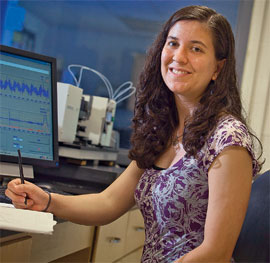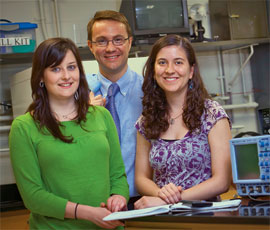The Right Stuff


During her first year, Melissa Gordon ’11 fell in love with her major’s biological and medical applications through a course on nanotechnology taught by James Ferri, associate professor and head of chemical and biomolecular engineering. Now after four years of hard work in the classroom and laboratory at Lafayette, she is continuing to pursue her passion for chemical engineering in a doctoral program at Princeton University.
Gordon is one of three 2011 graduates who have received National Science Foundation (NSF) Graduate Research Fellowships allowing them to attend top graduate school programs. Fellow chemical engineering graduate Lauren Huyett ’11 is pursuing a Ph.D. at University of California, Santa Barbara, where she is researching better medical diagnostic techniques, and civil engineering graduate Robert Elliott ’11 is attending Columbia University focusing on converting unused flat roofs into comfortable roof gardens.
The fellowships provide $30,000 annual stipends for a maximum of three years. Recipients are selected based on overall abilities and accomplishments, as well as potential to contribute to strengthening the vitality of the United States science and engineering industries.
Gordon worked with Ferri on research to design patterns for microfluidic devices and her honors thesis on optimizing voxel resolution in materials additive manufacturing. She also performed research with Steven Mylon, associate professor of chemistry, on research involving the bacteriophage MS2, a soft nanoparticle. She served an internship with Richard Brotzman ’75, principal nanotechnology development engineer, at Argonne National Laboratory in Lemont, Ill., studying the synthesis of superparamagnetic nanoparticles for use in adhesives.

She presented her work at the American Institute of Chemical Engineers 2010 annual meeting and the American Chemical Society’s 2011 national meeting and exposition.
“Lafayette gave me the opportunity to develop close relationships with faculty that helped me plan my future,” says Gordon. “I learned a great deal in my courses and appreciate all the advice I got about applying to graduate school and the NSF from Professors Ferri and Mylon. Their guidance was invaluable in preparing me for my future.”
Huyett participated in the NSF Research Experience for Undergraduates at Worcester Polytechnic Institute, where she was part of a team that investigated cranberry juice as a preventative measure against urinary tract infections. She presented her results at the Biomedical Engineering Society’s 2009 national conference.
On campus, she worked on research characterizing nanoparticles for use in drug delivery systems, as well as her honors thesis on the adsorption kinetics of the bacteriophage MS2. For her work, she also received a Goldwater Scholarship in 2010. Awarded for academic merit, the Goldwater is the premier undergraduate award of its type in the fields of mathematics, science, and engineering.
“What I like about chemical engineering is that it takes the fields of chemistry, mathematics, and physics, and combines them to address real-world problems in healthcare, energy, and other crucial areas,” explains Huyett. “My professors really encouraged me to go after opportunities like the NSF fellowship. The undergraduate research I’ve done at Lafayette has prepared me to start doing research at the graduate level.”
As a first-year student, Elliott joined a team of upperclassmen that designed a school site to meet LEED criteria and competed in the United States Green Building Council Natural Talent Design Competition. He studied sustainable architecture for a semester at the Danish Institute for Study Abroad in Copenhagen.
With the 2010 Jeffrey B. Havens ’78 Memorial Award, he traveled to Europe to study the infrastructure transformations of cities like Salzburg, Austria, and Rimini and Venice, Italy. For his honors thesis, advised by David Veshosky, associate professor of civil and environmental engineering, he investigated the performance of unconventional vegetative roof models in lab conditions and assessed the feasibility of implementing green roofs on existing structures.
“Civil engineering and architecture both focus on how the built environment can improve the quality of life, and I feel this is where I can do the greatest good for society,” says Elliott, who also graduated with a minor in architectural studies. “Pursuing a graduate degree allows me to perform original research which will hopefully add to the knowledge base of humanity in a positive way. By making the green roofs inhabitable and architecturally strong, small private natural sanctuaries for humans are formed, leading to more livable cities.”